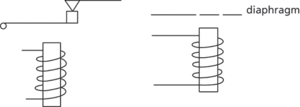An electrical or electronic device in which a variation in the current in one circuit controls the current in a second circuit. These devices are used in an enormous number of different applications in which electrical control is required. The simplest is the electromechanical relay in which the first circuit energizes an electromagnet, which operates a switch in a second circuit. The thyratron gas-filled relay found many uses in the past but has now been largely replaced by the thyristor solid-state relay.
1. In networking, a means of passing information between two or more networks, each offering a similar network function but each using a different protocol. In general a relay differs from a gateway or bridge in offering a store and forward service rather than a real-time service. As an example, a mail relay may be used to pass mail messages between networks using different mail protocols. See also cell relay, frame relay.
The term relay is used in some communities as synonymous with bridge or gateway. These three terms have meanings that vary between different communities at the same time, and within a given community at different times.
2. An electrically controlled switch enabling small signals to control much larger powers than would normally be possible as well as providing isolation between circuits. Various contact arrangements, e.g. normally open, normally closed, change-over and multiple poles, are available, as are bistable versions.
An electrical device in which one electrical phenomenon (current, voltage, etc.) controls the switching on or off of an independent electrical phenomenon. There are many types of relay, most of which are either electromagnetic or solid-state relays.
The armature relay is an electromagnetic relay in which a coil wound on a soft-iron core attracts a pivoted armature that operates contacts or tilts a mercury switch (Fig. a). There are several different designs for the armature: differential relays have two coils and only operate when the currents in the coils are additive not subtractive. The armature may be split so that a small section of the metal operates with small currents independently of the main contacts, which require large currents to move the whole armature; polarized relays have a central permanently magnetized core and operate differently with currents in different directions.

(a) Armature relay (b) Diaphragm relay
The electromagnetic diaphragm relay has a coil wound around a central core with a thin metal diaphragm plate mounted close to its end (Fig. b). When the coil is energized the central portion of the diaphragm moves towards the core and makes contact with it.
A true solid-state relay has all its components made from solid-state devices and involves no mechanical movement. Isolation between input and output terminals is provided using a light-emitting diode (LED) in conjunction with a photodetector. The switching is achieved using a thyristor or bidirectional thyristor (a triac). This type of relay is compatible with digital circuitry and has a wide variety of uses with such circuits. The relay cannot normally be formed on a single chip since the LED is usually formed in gallium arsenide and the photodetector in silicon. Isolation may also be achieved by transformer-coupling on the input. Again a single chip may not be used. Examples of solid-state relays are shown in Figs. c and d.

(c) LED-coupled solid-state relay (d) Transformer-coupled solid-state relay
Solid-state relays have advantages over electromechanical relays because of increased lifetime, particularly at a high rate of switching, decreased electrical noise, compatibility with digital circuitry, and ability to be used in explosive environments since there are no contacts across which arcs can form; the lack of physical contacts and moving elements also gives increased resistance to corrosion. No mechanical noise is associated with them. Disadvantages include the substantial amount of heat generated at a current above several amperes, necessitating some form of cooling, and greatly increased production costs for multipole devices compared to single pole devices; in certain applications a physical disconnection may be required for safety purposes and this is not available in solid-state relays.
Other types of relay include thermionically operated relays in which the heating effect of a current is used to operate contacts or the effect of a heating coil on a bimetallic strip is employed.
Relays are frequently described by the electrical parameter that causes them to operate or according to their function. Current relays and voltage relays operate when a predetermined value of current or voltage is applied to the input circuit.
A locking relay is used to render a circuit, device, or other apparatus inoperative under particular conditions, especially fault conditions. A slow-operating relay has an intentional delay between the energizing input and operation of the contacts; it includes some form of time-delay mechanism to achieve this.
http://www.esterline.com/powersystems/ProductSupport/DesignReference/RelayHandbook.aspx Engineer’s Relay Handbook, from the Relay and Switch Industry Association (RSIA)
- Feokitstov, Konstantin (1926–2009)
- feral animal
- Ferdinand
- Ferdinand II (1578–1637)
- Ferdinand V (1452–1516)
- Ferdinand VII (1784–1833)
- Ferguson, Adam (1723–1816)
- Fermat, Pierre de
- Fermat, Pierre de (1601–65)
- Fermat, Pierre de (1607–65)
- Fermat point
- Fermat prime
- Fermat’s Last Theorem
- Fermat’s Little Theorem
- Fermat’s principle
- Fermat’s Theorem
- Fermat’s Two Squares Theorem
- fermentation
- fermenter
- fermi
- Fermi acceleration
- Fermi constant
- Fermi energy
- Fermi, Enrico
- Fermi, Enrico (1901–54)